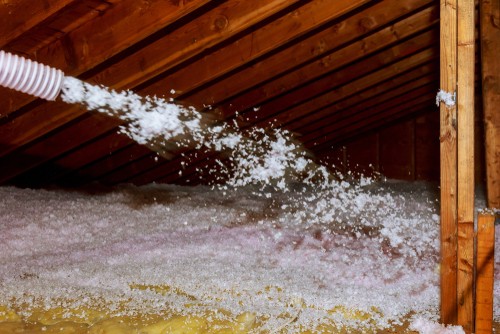There are many reasons to get to know the types of insulation available- when used properly, efficient insulation can reduce energy loss in your home and even decrease your energy bill. There are many different types of insulation materials on the market, and when it comes to choosing the right insulation for your home, it can be a bit overwhelming.
In this blog we break down the different factors of each material such as density, price, environmental impact and flammability that can help to decide which material would work best for you.
The four most common types of insulation are Fiberglass, Mineral Wool, Cellulose and Polyurethane Foam. Although they are all efficient in insulating your home, they each have different qualities – here’s how you can figure out which one’s for you:
Fiberglass
Fiberglass is a material made from recycled glass fibers and polyester, and is the most commonly used form of insulation. It is usually sold in standard sizes (or batts) to fit in wall spacing and tends to be cheaper than the other materials. Due to the make of the material, there is a risk of the glass fibers causing discomfort when in contact with skin. During application, it is important to have your skin completely covered, and even wearing a face mask to prevent lung damage.
Mineral Wool
Mineral wool is a viable option for insulation similar to fiberglass, but it is a little bit denser and tends to be more expensive. It is made from recycled industrial waste. A good thing about mineral wool is that it is very sturdy and can stay in place without support, making it easy to install. Most mineral wool is not fire resistant, making it unsuitable for areas with extreme heat.
Cellulose
Cellulose is perhaps the most environmentally friendly insulation material you can buy. It is made of almost entirely recycled newspaper. A challenge with cellulose, however, is that it only comes in the form of loose fill – with means it is not bound together in batts or rolls for easy application. Cellulose needs to be blown in using an applicator, which would most likely require professional assistance. Cellulose is also highly flammable due to its makeup, but it is good for areas that already have insulation for an extra boost.
Polyurethane Foam
Polyurethane foam, often referred to as “spray foam,” is made from colorless thermoplastic, and is sprayed directly on the area to be insulated. During application, it is important that no one occupies the area for a certain amount of time after application due to chemicals in the air. It is a lightweight and fire resistant and is very effective at insulation – when installed properly. It is difficult to know how much should be sprayed on and how to properly apply so that it won’t contract and peel off, so it is recommended to have a professional apply this type of material.
Best Type of Insulation for Your Home
It is important to know which material would work best for your individual home and lifestyle. When deciding on insulation, it may be beneficial to look up the recommended R factor of insulation for your Mid-Atlantic climate (this can be found on energy.gov) to further narrow down your options. Overall, insulating your home is an efficient choice and will benefit you, your wallet, and the environment.
Just as insulation keeps energy costs down so do quality replacement windows. At Thompson Creek we custom design, build and install our windows so you always get a perfect fit and that makes all the difference in energy efficiency. Energy Star reports that replacing old windows with Energy Star certified windows lowers household energy bills by an average of 12% nationwide, depending on the size of your home and your climate.
A Thompson Creek professional can help you start saving today. Give us a call for a free estimate on your replacement windows.


